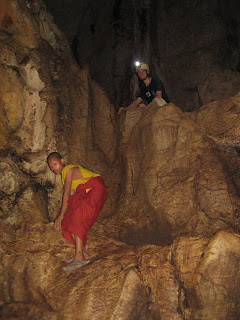Little is known about the caves and karsts of Cambodia. LIZ PRICE joined a German team on an exploratory expedition to Battembang Province.
Published on Wild Asia.






There have been very few caving expeditions to Cambodia and until recently little has been known about the karst and caves there. Reasons Cambodia has not attracted spelaeologists include the instability of the country resulting from wars, the Pol Pot regime and also the dangers from landmines.
Pol Pot's insane regime during which thousands of Cambodians were killed only ended in December 1978. A civil war then followed for the next 20 years. Thousands of mines were planted, along roads, in rice fields, in fact almost everywhere. Thousands more Cambodians died from the fighting and from the landmines. Peace only resumed in 1991 when King Sihanouk returned.
At the end of 1995 a German expedition looked at caves in Kratie and Kampot. In 2004 I went to Cambodia as a tourist and went to the "Killing caves" at Battambang.In June 2008 I joined a small scale expedition to explore the caves and karst of Battambang province. The team consisted of 2 Germans and myself.
In 14 days of caving, 65 caves were registered, and 54 of those were visited and 45 of them mapped. A total of 4,253 m of passage was surveyed. This was pretty good going.
In Battambang province the limestone extends from west of Battambang town and continues west towards Pailin on the Thailand border. The landscape from Battambang to at least Sdao is totally flat with the karst hills rising up to 300m from the plain. All the caves we looked at were dry, even though it was the rainy season.
The studies were conducted in cooperation with the Ministry of Culture and Fine Arts in Phnom Penh, and the Museum of Antiquities in Battambang. We hired a vehicle and driver and each day drove to the hills and asked the locals for caves. At first we were only taken to temple caves and other caves containing Buddhas, until we made it clear that we wanted all caves, not just religious sites.
However we soon found that the caves at the tops of the hills were generally small, sometimes they were just cavities. As it was so hot and sweaty to get to these caves, we then asked only for foothill caves.
The road No 10 from Battambang to Phnom Sampeu was in terrible condition in 2004. I hoped it would have improved by 2008, as it leads to the Thai border, but if anything it was worse. It took almost an hour to do the 14 km to Phnom Sampeu. Phnom Sampeu is the famous hill all the tourists visit, as it contains the killing caves and has some wats on top. I found in the 4 years since my last visit, a lot of money has been donated (mainly from overseas) to make new shrines, stupas, Buddha statues, signboards etc. Yet a lot of Cambodians are lucky if they live on $1 a day.
Some of the caves we visited were so full of bats we couldn’t enter, because of the stench of guano (and possible histoplasmosis). At one cave the smell was like pure ammonia, produced by the resident free tailed bats (Tadarida spp.).
It was good to see the bats in the caves however, because in the caves in northern Laos, most of the bats have been caught for food, and we were lucky if we saw just one or two bats. Bats support the rest of the food chain in caves. The caves in Battambang were home to a few invertebrates, such as centipedes, long legged centipedes (Thereupoda), crickets, millipedes, spiders and whip spiders (amblypygids). We found a snake in one cave, a striped kukri (Oligodon taeniatus), but this was probably an accidental visitor.
On 3 caving expeditions to northern Laos, it is obvious that the locals (mainly Hmong minorities) eat any wildlife they can catch. The markets each morning were a great place to take photos of wildlife, there were rats, squirrels, moon rats, porcupine, bats and many types of bird. In Cambodia's Battambang province, I found no evidence that the people eat the wildlife, and unlike in Laos, we saw birds flying around.
Laang Spean, Bridge Cave, is an archaeological site dug in the 1970s. Finds include stone tools from 6000-7000 BC and pottery from ~4290 BC, as well as animal bones. We visited another nearby cave and found some pottery, bones and stone tools, which were taken by the Museum guys.
A full expedition report will be published in due course, and another article will appear in the British caving magazine Speleology in Autumn 2008.
© Liz Price - article may only be republished with the author's permission.

